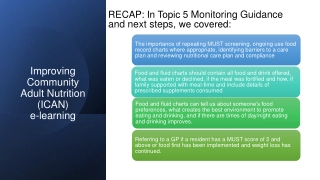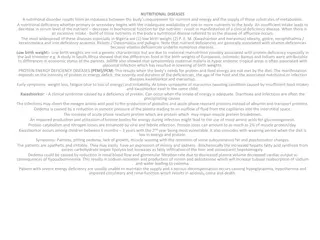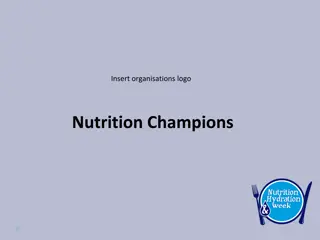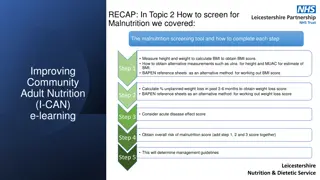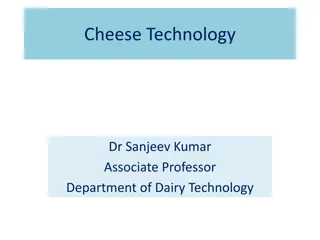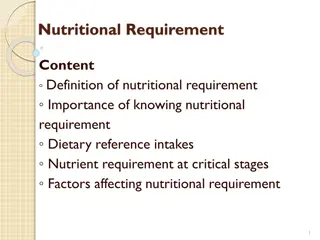
Nutritional Assessment Process for Better Health Outcomes
Explore the systematic process of nutritional assessment, including dietary methods, components, and benefits. Learn how health professionals use this information to identify and address nutrition-related health issues effectively.
Download Presentation

Please find below an Image/Link to download the presentation.
The content on the website is provided AS IS for your information and personal use only. It may not be sold, licensed, or shared on other websites without obtaining consent from the author. If you encounter any issues during the download, it is possible that the publisher has removed the file from their server.
You are allowed to download the files provided on this website for personal or commercial use, subject to the condition that they are used lawfully. All files are the property of their respective owners.
The content on the website is provided AS IS for your information and personal use only. It may not be sold, licensed, or shared on other websites without obtaining consent from the author.
E N D
Presentation Transcript
StudyMafia.Org Nutritional Assesment Submitted To: Studymafia.org Studymafia.org Submitted By:
Table Contents Definition Introduction Dietary Methods Components of Nutritional Assessment Process of Nutritional Assessment Methods of Nutritional Assessment Benefits of Nutritional Assessment Conclusion 2
Definition Nutritional assessment is the systematic process of collecting and interpreting information in order to make decisions about the nature and cause of nutrition related health issues that affect an individual 3
Introduction This differs from nutritional screening (link to Screening and MUST page) which is a brief risk assessment which can be carried out by any healthcare professional and which may lead to a nutritional assessment by a dietetician. Following a structured assessment path enables health professionals to carry out a quality nutritional assessment in order to identify those who need nutritional intervention, and to improve clinical decision making using a person centred approach. 4
Components of Nutritional Assessment Anthropometrics Anthropometrics refers to body size and composition determination. In clinical settings, measurements such as height, weight and head circumference help identify abnormal growth patterns. Results are compared to standard pre-determined values. Body mass index, or BMI, uses height and weight measurements as the basis for assessing obesity and chronic disease risk. 6
Components of Nutritional Assessment Biochemical Data Laboratory measurements of nutrients or other chemicals in blood, stool or urine constitute the biochemical component of nutrition assessment. Hemoglobin and ferritin blood tests reflect iron status. Inflammation can be assessed with albumin and C- reactive protein blood levels. Cholesterol and lipoprotein blood test results indicate heart disease risk. Analyzing stool samples may uncover the presence of blood, indicative of abnormal gastrointestinal tract bleeding. 7
Components of Nutritional Assessment Clinical Methods A physical exam coupled with a complete medical history aid in malnutrition determination and measurement of its degree of severity. For example, the loss of tooth enamel may indicate frequent vomiting, a sign of bulimia. Visual observation of the presence or loss of normal muscle tone can indicate protein deficiency. Medical chart review and interviews with an individual may uncover past surgical procedures, medication interactions and drug or alcohol use. 8
Components of Nutritional Assessment Dietary Analyzing the nutritional adequacy of an individual s diet provides information relative to fat, protein, carbohydrate, water, vitamin, mineral and fiber intake. Obtained through verbal or written means, individuals review foods eaten during a specified time period, normally 24 hours or three days. A full week's food intake record may be needed for chronic nutritional concerns. Specially designed computer software programs are used for food record analysis, and results are compared to the U. S. Dietary Guidelines or Dietary Reference Intakes. 9
Process of Nutritional Assessment 10
Methods of Nutritional Assessment Nutrition surveys It is cross-sectional evaluations of selected population groups; conducted to generate baseline nutritional data, to learn overall nutrition status, and to identify subgroups at nutritional risk 11
Methods of Nutritional Assessment Nutrition surveillance It is continuous monitoring of the nutritional status of selected population groups (e.g., at-risk groups) for an extended period of time; conducted to identify possible causes of malnutrition 12
Methods of Nutritional Assessment Nutrition screening It is comparison of individuals parameters of nutritional status with predetermined standards; conducted malnourished individuals nutritional intervention. to identify requiring 13
Benefits of Nutritional Assessment 14
Conclusion Nutritional assessment at the population level is of increasing relevance in the world. Availability of reliable and precise information in this area shapes development in many ways. It enhances understanding of national nutritional scenarios, provides necessary tools for crafting and monitoring development interventions, and guides decision-makers towards improved planning and policy-making in matters of public health. 15
References Google.com Wikipedia.org Studymafia.org Slidespanda.com
Thanks To StudyMafia.org


